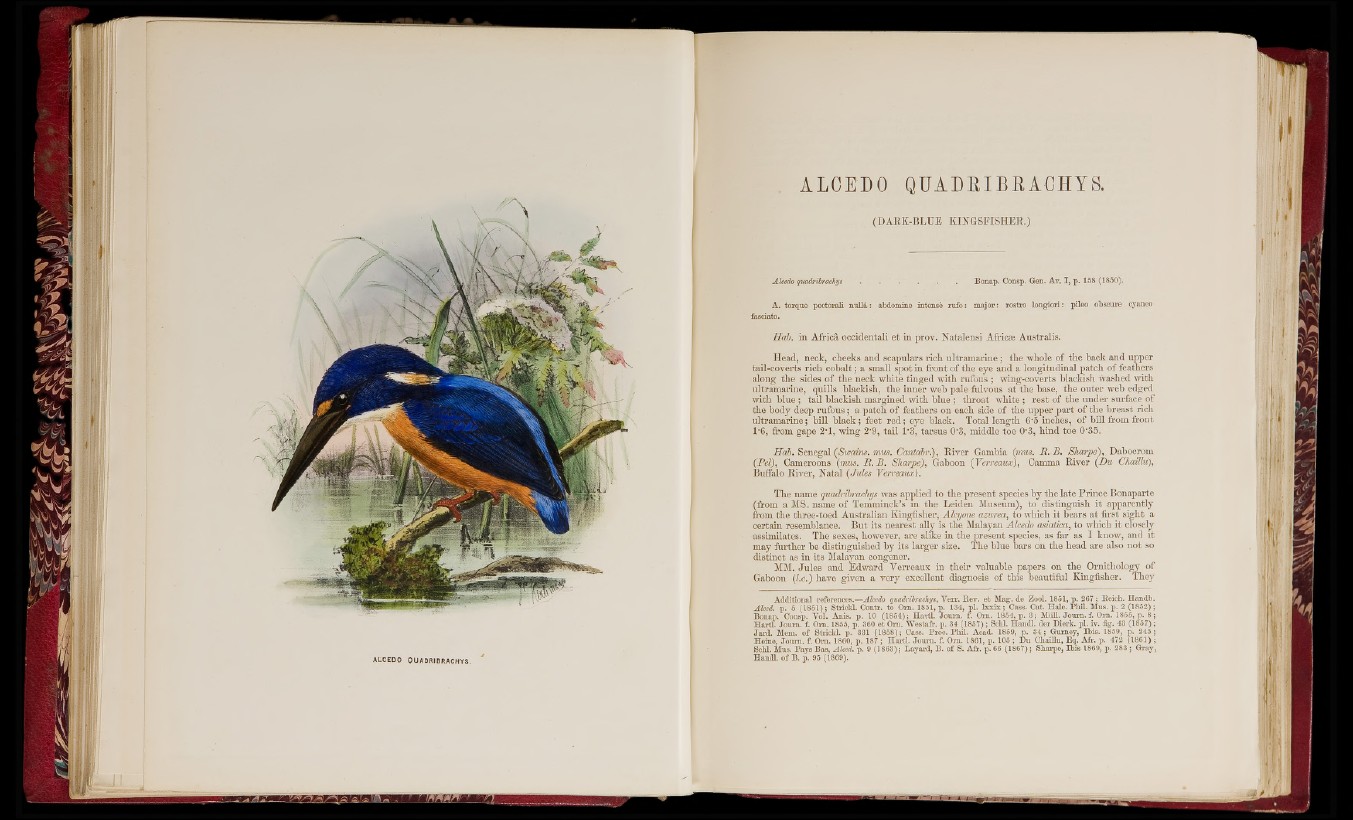
____ n
i
1 h
iIffl I
Hi
ALCEDO QITADDIBDACHTS.
(D A RK -B LU E K IN G S F ISH E R .)
Alcedo q u a d r ih r a c h y s Bonap. Consp. Gen. Av. I, p. 158 (1850).
A. toi-que pectorali nullá: abdomine intense rufo: major: rostro longiori: pileo obscure cyaneo
Hah. in Africa occidentali e t in prov. Natalensi Africæ Australis.
Head, neck, cheeks and scapulars rich ultram a rin e ; the whole o f th e back and upper
tail-coverts rich cobalt ; a small spot in fro n t o f the eye and a longitudinal patch o f feathers
along th e sides o f th e neck wh ite tin g ed with rufous ; wing-coverts blackish washed with
ultrama rine , quills blackish, the in n er web pale fulvous a t the base, th e outer web edged
with blue ; ta d blackish margined with blue ; th ro a t white ; re s t o f the u n d e r surface of
the body deep rufous ; a patch o f feathers on each side o f the u pper pai’t o f tho b rea st rich
u ltram a rin e ; b ill b la c k ; feet r e d ; eye black. Total len g th 6-5 inches, of b ill from fro n t
1-6, from gape 2-1, wing 2*9, ta il i '3 , tarsu s 0'3, middle toe 0 ‘3, h in d toe 0 ‘35.
Hah. Senegal {Sioahis. mm. Cantahr.), R iv er Gambia (îîiw.*?. R . B . Sharpe), Dabocrom
(Pel), Cameroons {mus. R . B . Sharpe), (j-aboon [Verreaux), Camma River ( t)u Chaillu),
Buffalo River, Natal {Jules Verreaux).
The name quadribrachys was applied to the p resent species by the late P rin c e Bonaparte
(from a MS. name o f Temmiuck’s in the Leiden Museum), to d istinguish i t apparently
from the thre e-toed Au stra lian Kmgfisher, Alcyone azurea, to which i t bears a t first sig h t a
certain resemblance. B u t its n earest ally is th e Malayan Alcedo asiatica, to which it closely
assimilates. The sexes, however, are alike in th e p resent species, as far
............................................................... The blue 1
I know, and it
may fu rth e r be distinguished by its larg e r size, Li*s on the head are also n o t so
distinct as in its ila la y a n congener.
M il. J u le s and Edw ard Verreaux in th e ir valuable papers on th e Ornithology of
Gaboon {I.e.) have given a v e ry excellent diagnosis o f th is beautiful Kingfisher. They
Adclitionnl references.—Alcedo quadrilrachys, Yerr. Eev. et Mag. do Zool. 1851, p. 2C7 ; Eeieh. Handh.
Alced. p. 5 (1851) ; Strickl. Contr. to Om. 1851, p. 134, pi. k x ix ; Cass. Cat. Hale. Phil. Mas. p. 2 (1852) ;
Bonap. Consp. Vol. Anis. p. 10 (1854); Hartl. Joum. f. Om. 1854, p. 3; Müll. Journ. f. Om. 1855, p. 8;
Hartl. Joum. f. Om. 1855, p. 360 et Om. Westafr. p. 34 (1857) ; Sebi. Handl. der Dierk. pi. iv. fig. 43 (1857) ;
Jard. Mem. of Stridei, p. 331 (1858); Cass. Proc. Phìi. Acad. 1859, p. 34; Gurney, Ibis. 1859, p. 2-15;
Heine, Joum. f. Om. 1860, p. 187 ; Hartl. Joum. f. Om. 1861, p. 105 ; Du Chaillu, Eq. Afr. p. 472 (1861) ;
Schl. Mus. Pays Bas, Alced. p. 9 (1863) ; Layard, B. of S. Afr. p. 66 (1867) ; Shaipo, Ibis 1869, p. 288 ; Gray,
Handl. of B. p. 95 (1869).